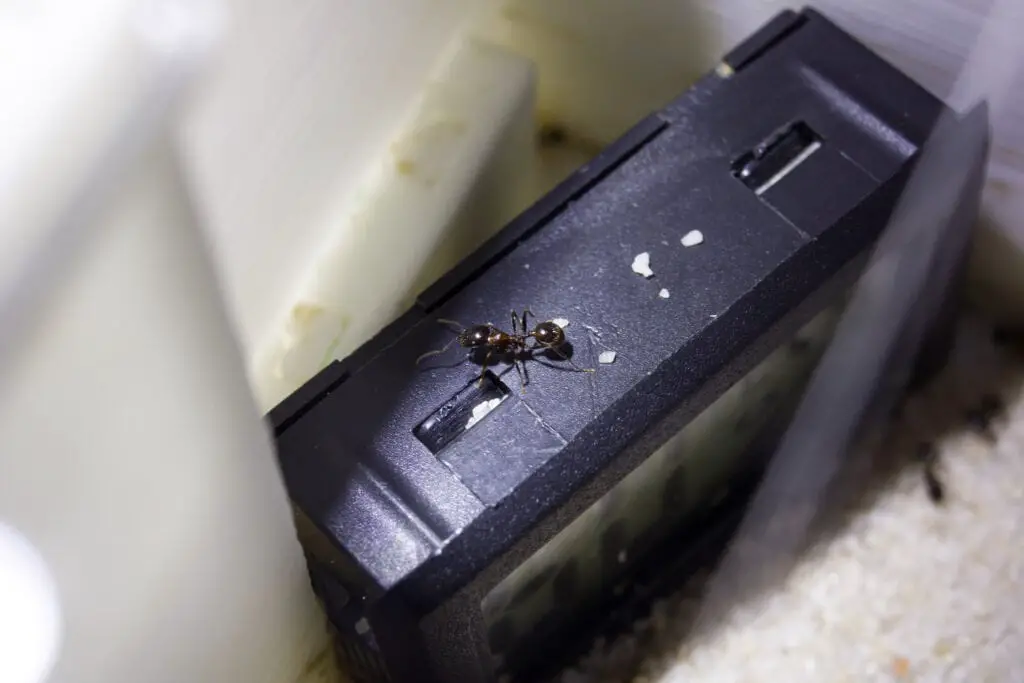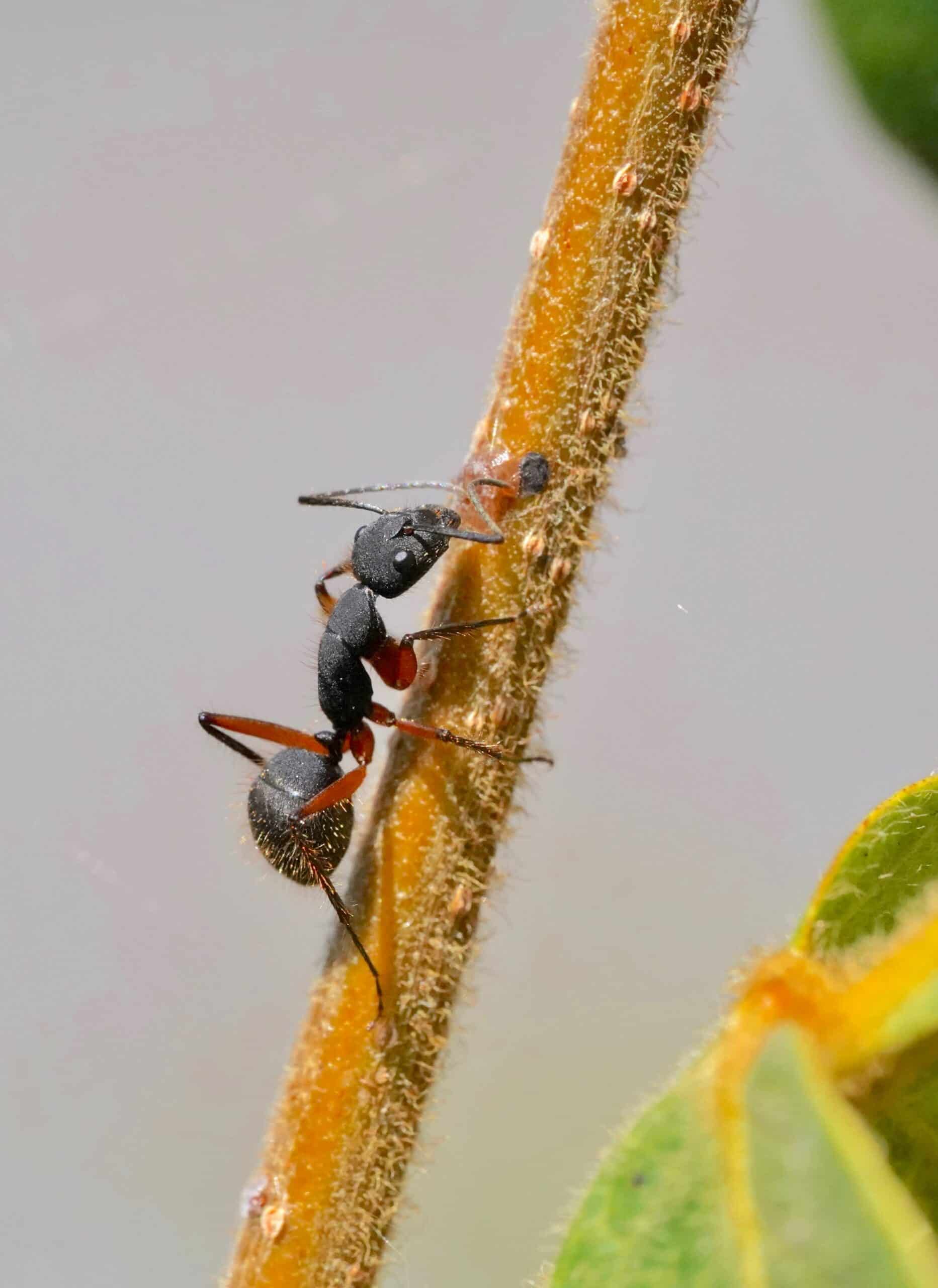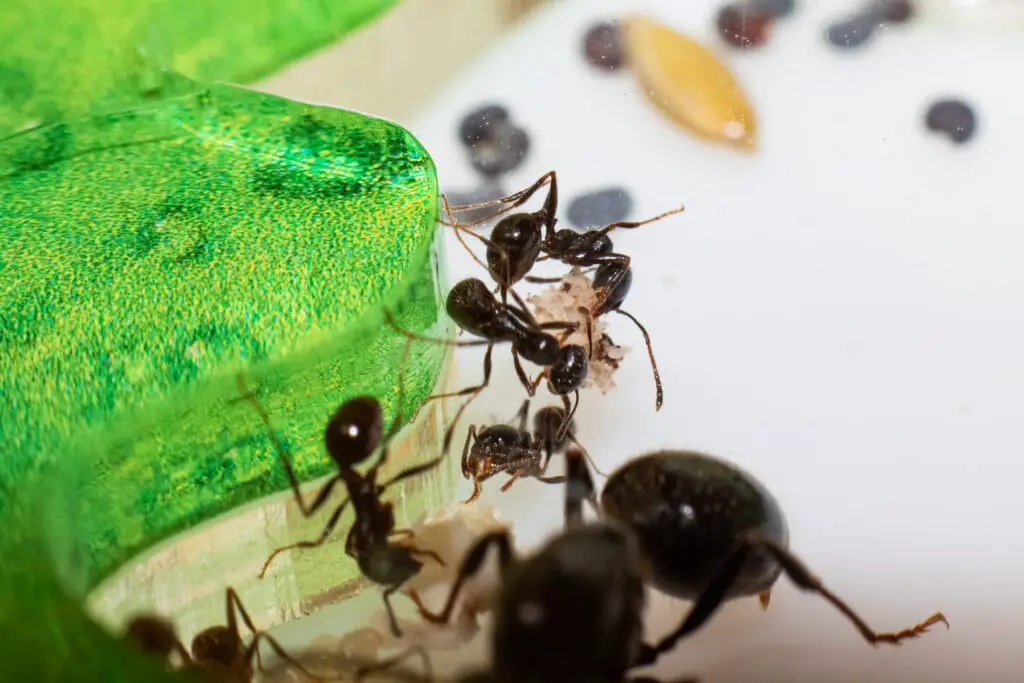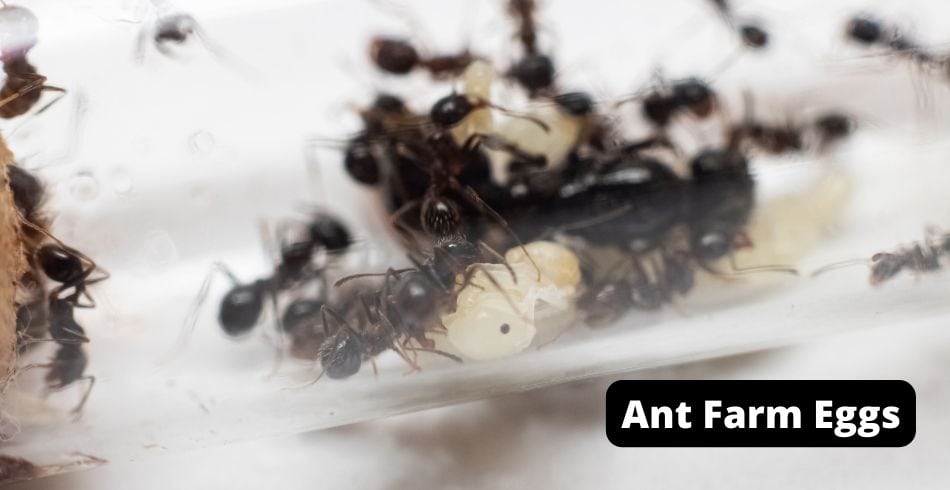In the wild, ants prioritize safe locations for the offspring, like any other animal on the planet that reproduces. An ant’s survival and reproduction determine the colony’s future. Even on your ant farm, many wonder about their eggs and how reproduction in ants will work.
Reproduction in Ants is not complicated or very unique. Ants pass through four different stages during metamorphosis. These four cycles are the egg stage, the larva stage, the pupa stage, and the adult stage. All of these kick off right after the queen has mated with a male ant, who shortly dies after.
Ant Farm Eggs
An ant colony comes into existence following a series of phases.
The initial phase is the development phase.
The queen ant leaves the nest in swarms to meet the ant drones who also leave the nest in multitudes.
The aim is to mate.
Despite flying out in swarms, only a few get the chance to mate and start their colonies.
The swarm of ants encounters predators such as birds, frogs, and chameleons that prey on them.
This is also where you will probably find your Queen Ant.
If you did, stuff her into a test tube and leave her alone!
The male ants lose their wings after mating.
They drop them on the grounds and usually get eaten by predators.
The queen also loses her wings and falls to the ground.
In the wild, once she has mated she goes into the soil and starts a colony.
This is why we leave our test tube ant farm alone and in the dark, as our Queen Ant needs an environment that mimics this “digging into the soil” process.
For some species, the queen ants join to form a colony together, and in some, the queen ant starts her colony alone.
For your ant farm, you should stick with one queen.

The very first brood comprises only workers.
Who in their adulthood work to enlarge the nest and create tunnels.
Once in their formicarium, they will also create new breeding chambers and move eggs into these new chambers for safety.
The workers also clean, feed, and groom the queen ant.
They provide food and clean the hatched larvae (eggs).
They also protect the pupa either in cocoons or outside without the cocoons.
The colonies’ next move is into the ergonomic stage.
Here the workers dedicate their time to colony expansion work.
The ergonomic stage takes about five years.
After which the colony is large enough to enter the reproductive stage
In the reproductive stage, the colony size is usually pretty big.
It’s enough to start producing queen ants.
Also, male ants get hatched and leave the nest to mate and form new colonies.
How Is A Queen Ant Born
Once a colony has reached full development, the Queen Ant will produce fertile female ants (compared to infertile worker ants) that will go off and start their own colony. This does not happen early in the development cycle of an ant colony, as the queen ant needs all the workers she can get.
How Do Ants Mate
Reproduction in ants involves searching, selecting, and females.
Fertilization sees that the eggs laid will survive the different stages of the life cycle.
The female, in this case, is a winged queen. The wings help perform a long-distance nuptial flight.
Here mating happens in the humid, warm air. After mating, the male dies, and the queen ant loses her wings.
The queen ant drops on the moist warm ground and buries herself deep into the soil, hoping it’s a suitable place to start her colony.
During the first gestation period, the queen ant does not eat.

Instead, she gets needed nutrients from the wing muscles since she will no longer need to use them again.
Within the short mating period, the winged queen ant mates with more than one winged male ant.
The queen ant does not mate again.
Near the tip of the abdomen is a pouch called the spermatheca.
Where the queen ant stores the sperms collected from the male ants.
During fertilization, the queen ant opens a valve. It allows the sperm to fertilize the eggs in her reproductive tract.
Ant Reproductive Cycle
Many species can produce flying males and queens at specific periods of the year. The main objective of the males is to procreate with the queens.
To mate, the males and the queen rise into the air.
The males die soon after.
After that, each queen lays her eggs and builds a new nest.
The ant has four phases in its life cycle: egg, larva, pupa, and adult.
There are no eyeballs or legs on the larvae.
The larvae shed their skin multiple times after hatching from the eggs.
While larvae grow into adults, the workers and queen spin a silky cocoon over themselves and sleep inside.
When a pupa is able to emerge from its cocoon, a nursing ant cuts a hole in the silken covering and assists the feeble little ant in emerging.
She then cleans and feeds it.
The majority of ants survive for 6 to 10 weeks, but some can survive for up to 15 years.
Social insects such as bees and wasps undergo complete metamorphosis.
The ant is a little different.
This social insect undergoes a four-stage metamorphosis.
The four gestation stages are egg, larvae, pupa, and adult.
The process from egg to adult can take about 60 days to complete.
Imagine if kids went from babies to adults in 60 days.
The Egg Stage
The queen ant lays both fertilized and unfertilized eggs.
An egg being Fertilized or unfertilized determines the future gender of the ant.
Queen ant chooses which eggs to fertilize and which not to fertilize.
The fertilized eggs develop to become female ants. They are the workers in a colony.
The workers tend to the eggs, larvae, and queen, search for food, and guard the nest.

The unfertilized eggs develop into males.
To ensure there is no queen ant hatched, the queen ant secrets a chemical that stops the growth of wings and ovaries.
It makes the female ants infertile and incapable of reproducing.
Hence these ants cannot be queens of the colony.
Queen ants get produced when there are a suitable amount of workers.
Enough to serve the queen and provide enough food.
The winged male ants fly out of the nest upon maturity to mate with queen ants. They die a short while after mating.
If a winged queen ant hatches in a colony, they leave the nest. They mate and build their colonies.
The eggs take one week to two weeks to hatch.
A mated queen ant lays a few eggs and feeds and nurtures the larvae to adulthood with their saliva.
Once mature, the queen ant has enough worker ants to provide for her and the larvae in much higher numbers.
The queen ant can lay about 800 eggs per day.
When the colony reaches the reproductive stage, it can hold about 500,000 worker ants.
The Larvae Stage
The laid eggs hatch into tiny maggot-resembling creatures. They have a transparent white color and have no legs and eyes.
The larvae grow hair that is hook-shaped, which helps the worker carry the larvae around. The larvae undergo a molting process. Here their skin peels off.
Their lack of legs and eyes make the larvae depend on the worker for food.
The larvae feed on solid and liquid nutrition. The ant larvae eat a lot resulting in their fast and rapid growth. Within the colony, some of the female ants, the workers, are responsible for taking care of the larvae alone.
The larvae stage takes between 7 to 14 days.
The Pupa Stage
The ant larvae now develop into ant pupa.
The ant pupa is white that resembles the adult ant. Some physical features like eyes, legs, and wings begin to appear at this stage. In the pupa stage, the ant’s movement gets restricted.
It’s because the pupa ant’s legs and antennae get folded against its body. Some of the larvae are in protective cocoons, while others remain uncovered. It depends on the ant’s species. The pupa stage is the final stage of the ant’s gestation period. It takes a pupa ant 9 to 30 days to develop into an adult ant. The pupa is dependent on the adult worker ant for feeding.
The Adult Worker Ant
After the pupa stage, the ant surfaces as full-grown and ready for tasks. The adult could be a winged female ant or a queen ant that leaves the colony to start its own.
Also, it could be a winged male ant that leaves the colony for mating purposes.
If the adult is a wingless female ant, It is a worker ant responsible for performing various tasks within the colony.
The job includes guarding, foraging, and serving the queen ant tending to the larvae and the eggs.
Adult ants vary in size and color depending on the ant species. Generally, adult ants have some similar features.
They have six legs with three joints on each leg with a hooked claw for climbing. Adult ants have large heads with compound eyes. Their antennas have elbow shapes.
They have a narrow constriction between the thorax and the abdomen called a petiole.
For feeding and cutting purposes, adult ants have potent mandibles.

Adult ants measure between o.oo8 inches to 1 inch in length.
There are a ton of different types of ants.
The most common colors associated with adult ants are black, brown, or red.
But we also have other species with other colors.
They feed on a wide variety of foods, some specific foods others a wide range. For instance, you’ll never see harvester ant-eating tons of meat.
This ant prefers the vegetation side of things, as hinted by its name.
Adult ants communicate through pheromones.
It is a distinct chemical they excrete. They apply different formulas to convey a given message. A queen ant can live for about three decades!
While the workers only live for about five weeks or longer. The protective workers can live for about seven years, depending on the species.
Protective workers undergo much less stress on their bodies. This is because they don’t leave the nest as much.
Final Thoughts about the Ant Reproductive Cycle
The queen’s relevance in the ant colony development and reproduction cycle is undeniable.
The queen ant determines the gender. And the reproduction cycle is always the heart of ant colony development and growth. Some of the workers will go out of the colony with a new queen to help her find a colony.
When the queen in a colony with only one egg-laying queen has their queen pass away, this means a slow decay of the colony. It’s basically destined for failure.
It’s due to a lack of continuation of the reproduction cycle.
The queen, despite receiving services from all these different types of ants, does not have power over the worker.
A colony may experience turmoil at times, and workers attack the queen.

The queen is always ready to defend herself; in some instances taking down many ants.
When the queen ant feels threatened in a colony, she stops laying eggs placing the colony’s future at extinction risk.
Remember this if you currently have your own formicarium, spooking the queen may slow down your colonies’ growth.
If you wanted a deep dive into getting started with ant keeping, this guideline here would work best: Beginner Friendly Ant Keeping Guide
Frequently Asked Questions
We know there are a ton of questions when it comes to the productive cycle on your ant farm, hopefully, some of these will help.
Are All Ants Female
All ants are not female. Many ants are male. These ants do not mate with the Queen Ant who produced them, but look for new queens to start colonies with. Both the new queen and the male ant have wings and go on a nuptial flight to breed.
Do Ants Lay Eggs
Ants do lay eggs. This is how their colony starts. The Queen Ant will lay the eggs to develop the colony. Once enough eggs are laid, she will produce fertilized female ants that will create new colonies. This is the final stage in the reproductive cycle for ants.
How Many Eggs Does An Ant Lay
Queen ants lay a wide range of eggs. Most clusters of eggs will be about a dozen. Some ants, like the Pharaoh ant, only lay in batches of 8-12, while ants like the Carpenter Ant lay in batches of upwards of 20.
Do Ants Hatch From Eggs
Ants do hatch from eggs. A queen ant will lay eggs for the colony, which will produce more ants. These ants can be unfertilized females, fertilized females, and males. Most of the hatched ants are unfertilized female ants, which will develop into worker ants.
Do Ants Carry Their Eggs
Ants carry their eggs all over. When ants find an area with more resources, the first thing they will migrate is the eggs from the colony. The Queen and Worker ants are constantly moving the eggs around to new areas, to create more space for other eggs.
